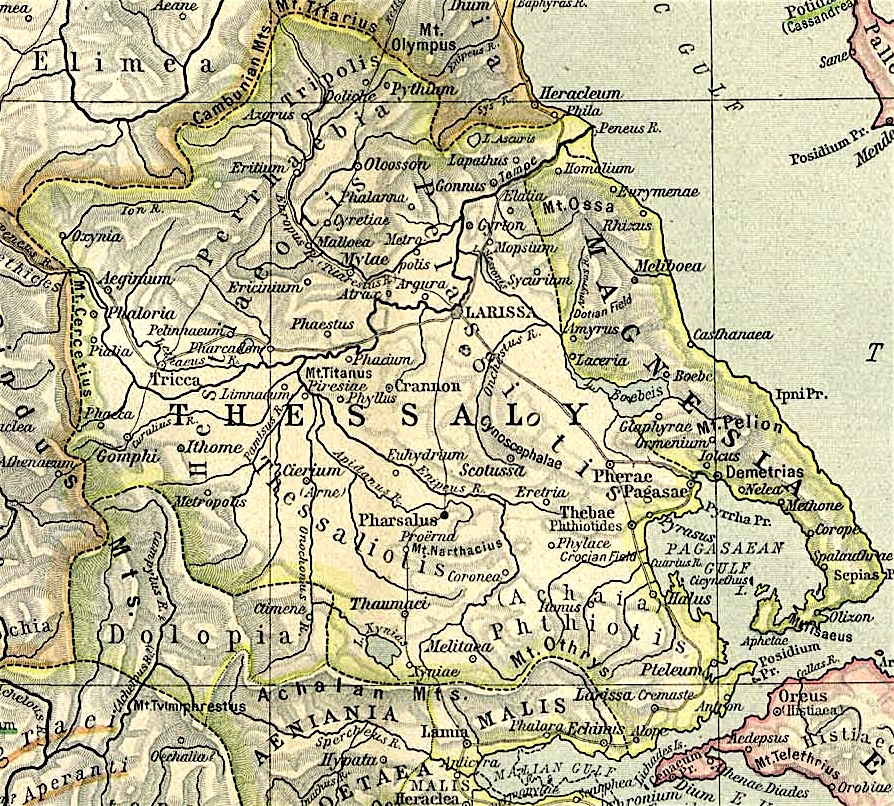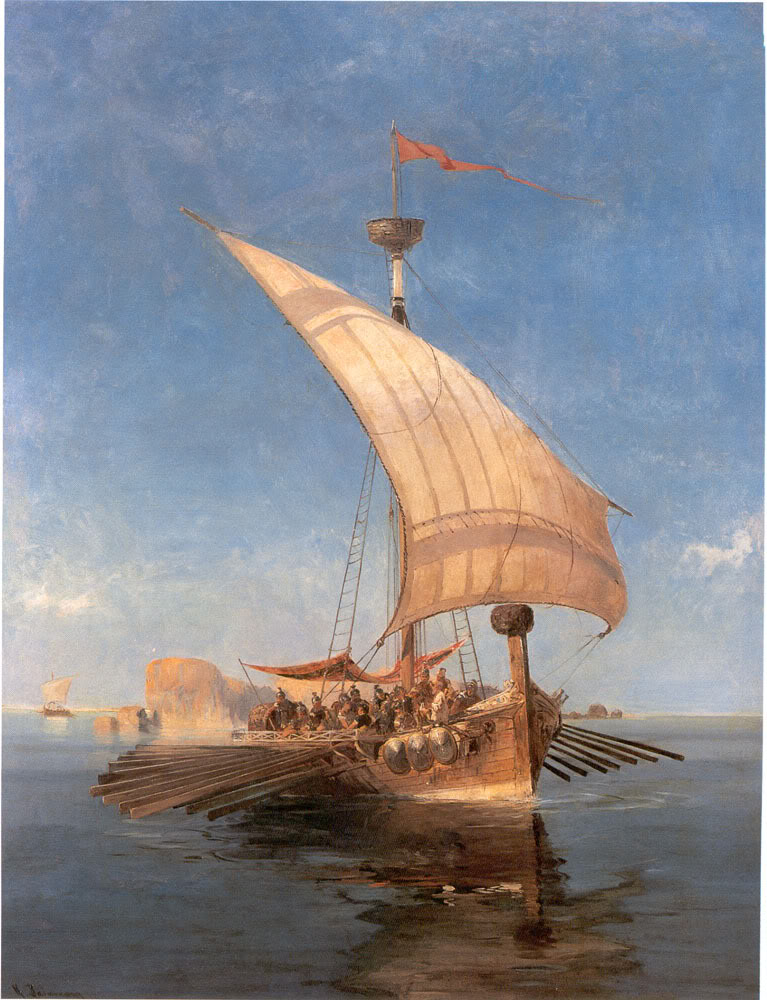|
Azorus
Azorus or Azoros ( or Ἀζώριον) was a town and polis (city-state) in Perrhaebia in ancient Thessaly situated at the foot of Mount Olympus. Azorus, with the two neighbouring towns of Pythium and Doliche, formed a Tripolis. During the Roman–Seleucid War, the Tripolis was ravaged by an army of the Aetolian League in the year 191 BCE. During the Third Macedonian War the three towns surrendered to the army of Perseus of Macedon in the year 171 BCE, but that same year the Romans reconquered the three. In the year 169 BCE troops arrived from the Roman consul Quintus Marcius Philippus who camped between Azorus and Doliche. The three cities minted a common coin with the inscription "ΤΡΙΠΟΛΙΤΑΝ". The site of Azorus is the ''palaiokastro'' (old fort) at the modern village of Azoros. According to the 5th-century grammarian Hesychius of Alexandria the town was named after the mythological Azorus, helmsman of the Argo In Greek mythology, the ''Argo ... [...More Info...] [...Related Items...] OR: [Wikipedia] [Google] [Baidu] |
Pythion
Pythion () or Pythium, also Pythoion (Πύθοιον) was a city and polis (city-state) of Perrhaebia in ancient Thessaly, situated at the foot of Mount Olympus, and forming a Tripolis with the two neighbouring towns of Azorus and Doliche. Pythion derived its name from a temple of Apollo Pythius situated on one of the summits of Olympus, as we learn from an epigram of Xeinagoras, a Greek mathematician, who measured the height of Olympus from these parts. Games were also celebrated here in honour of Apollo. Geography Pythion commanded an important pass across Mount Olympus. This pass and that of Tempe are the only two leading from Macedonia into the northeast of Thessaly. History During the reign of Amyntas III or Philip II, the Tripolis was annexed to Macedon. According to Theagenes the inhabitants of Balla were relocated to Pythion. So we find in 3rd century BC an epigram regarding Philarchos son of Hellanion, Macedonian Elimiote from Pythion, proxenos in Delphi. Duri ... [...More Info...] [...Related Items...] OR: [Wikipedia] [Google] [Baidu] |
Azoros
Azoros (, ) is a village and a community of the Elassona municipality in the Larissa regional unit.Kallikratis law Government’s Gazette Before the 2011 local government reform it was a part of the municipality of Sarantaporo, of which it was a municipal district. The community of Azoros covers an area of 20.308 km2. Geography Azoros is built at an altitude of 520 meters at the foot of Mount Amarbeis, at a distance of 18 kilometers from |
Doliche (Thessaly)
Doliche () was an ancient Greek city and polis (city-state) in Perrhaebia in Thessaly, situated at the foot of Mount Olympus. Doliche, with the two neighbouring towns of Azorus and Pythion (Pythium), formed a Tripolis. During the Roman–Seleucid War, the Tripolis was ravaged by an army of the Aetolian League in the year 191 BCE. During the Third Macedonian War the three towns surrendered to the army of Perseus of Macedon in the year 171 BCE, but that same year the Romans reconquered the three. In the year 169 BCE troops arrived from the Roman consul Quintus Marcius Philippus who camped between Azorus and Doliche. The three cities minted a common coin with the inscription "ΤΡΙΠΟΛΙΤΑΝ". The site is occupied by the modern town of Dolichi; when William Martin Leake visited the site in the 19th century, he found two fragments of Doric columns in diameter in a ruined church, and a sepulchral stone in the burying-ground, together with some squared bloc ... [...More Info...] [...Related Items...] OR: [Wikipedia] [Google] [Baidu] |
Perrhaebia
Perrhaebia () was the northernmost district of ancient Thessaly, where the tribe of the Perrhaebi lived. Major cities were: Pythion, Doliche, Azorus, Oloosson and Phalanna the capital. Perrhaebia was part of Macedon Macedonia ( ; , ), also called Macedon ( ), was an ancient kingdom on the periphery of Archaic and Classical Greece, which later became the dominant state of Hellenistic Greece. The kingdom was founded and initially ruled by the royal ...ia between the 4th and 1st centuries BC. References *In the shadow of Olympus By Eugene N. Borza Page 164 Historical regions in Greece Ancient Macedonia {{AncientThessaly-geo-stub ... [...More Info...] [...Related Items...] OR: [Wikipedia] [Google] [Baidu] |
Tripolis (Perrhaebia)
Tripolis (; meaning "three cities") was a district in ancient Perrhaebia, Thessaly, Greece, containing the three cities of Azorus, Pythion (Pythium), and Doliche. (Livy Titus Livius (; 59 BC – AD 17), known in English as Livy ( ), was a Roman historian. He wrote a monumental history of Rome and the Roman people, titled , covering the period from the earliest legends of Rome before the traditional founding i ..., xlii. 53.) References * Geography of ancient Thessaly Perrhaebia {{AncientThessaly-geo-stub ... [...More Info...] [...Related Items...] OR: [Wikipedia] [Google] [Baidu] |
Thessaly
Thessaly ( ; ; ancient Aeolic Greek#Thessalian, Thessalian: , ) is a traditional geographic regions of Greece, geographic and modern administrative regions of Greece, administrative region of Greece, comprising most of the ancient Thessaly, ancient region of the same name. Before the Greek Dark Ages, Thessaly was known as Aeolia (, ), and appears thus in Homer's ''Odyssey''. Thessaly Convention of Constantinople (1881), became part of the modern Greek state in 1881, after four and a half centuries of Ottoman Greece, Ottoman rule. Since 1987 it has formed one of the country's 13 Modern regions of Greece, regions and is further (since the Kallikratis reform of 2011) sub-divided into five regional units of Greece, regional units and 25 municipalities of Greece, municipalities. The capital of the region is Larissa. Thessaly lies in northern central Greece and borders the regions of Macedonia (Greece), Macedonia to the north, Epirus (region), Epirus to the west, Central Greece (geo ... [...More Info...] [...Related Items...] OR: [Wikipedia] [Google] [Baidu] |
Populated Places In Ancient Thessaly
Population is a set of humans or other organisms in a given region or area. Governments conduct a census to quantify the resident population size within a given jurisdiction. The term is also applied to non-human animals, microorganisms, and plants, and has specific uses within such fields as ecology and genetics. Etymology The word ''population'' is derived from the Late Latin ''populatio'' (a people, a multitude), which itself is derived from the Latin word ''populus'' (a people). Use of the term Social sciences In sociology and population geography, population refers to a group of human beings with some predefined feature in common, such as location, race, ethnicity, nationality, or religion. Ecology In ecology, a population is a group of organisms of the same species which inhabit the same geographical area and are capable of interbreeding. The area of a sexual population is the area where interbreeding is possible between any opposite-sex pair within the a ... [...More Info...] [...Related Items...] OR: [Wikipedia] [Google] [Baidu] |
Cities In Ancient Greece
A city is a human settlement of a substantial size. The term "city" has different meanings around the world and in some places the settlement can be very small. Even where the term is limited to larger settlements, there is no universally agreed definition of the lower boundary for their size. In a narrower sense, a city can be defined as a permanent and densely populated place with administratively defined boundaries whose members work primarily on non-agricultural tasks. Cities generally have extensive systems for housing, transportation, sanitation, utilities, land use, production of goods, and communication. Their density facilitates interaction between people, government organizations, and businesses, sometimes benefiting different parties in the process, such as improving the efficiency of goods and service distribution. Historically, city dwellers have been a small proportion of humanity overall, but following two centuries of unprecedented and rapid urbanization, more ... [...More Info...] [...Related Items...] OR: [Wikipedia] [Google] [Baidu] |
Former Populated Places In Greece
A former is an object, such as a template, gauge or cutting die, which is used to form something such as a boat's hull. Typically, a former gives shape to a structure that may have complex curvature. A former may become an integral part of the finished structure, as in an aircraft fuselage, or it may be removable, being used in the construction process and then discarded or re-used. Aircraft formers Formers are used in the construction of aircraft fuselage, of which a typical fuselage has a series from the nose cone to the empennage, typically perpendicular to the longitudinal axis of the aircraft. The primary purpose of formers is to establish the shape of the fuselage and reduce the column length of stringers to prevent instability. Formers are typically attached to longerons, which support the skin of the aircraft. The "former-and-longeron" technique (also called stations and stringers) was adopted from boat construction, and was typical of light aircraft built unt ... [...More Info...] [...Related Items...] OR: [Wikipedia] [Google] [Baidu] |
Dictionary Of Greek And Roman Biography And Mythology
The ''Dictionary of Greek and Roman Biography and Mythology'' is a biographical dictionary of classical antiquity, edited by William Smith (lexicographer), William Smith and originally published in London by John Taylor (English publisher), Taylor, Walton (and Maberly) and John Murray (publishing house), John Murray from 1844 to 1849 in three volumes of more than 3,700 pages. It is a classic work of 19th-century lexicography. The work is a companion to Smith's ''Dictionary of Greek and Roman Antiquities'' and ''Dictionary of Greek and Roman Geography''. Authors and scope The work lists thirty-five authors in addition to the editor, who was also the author of the unsigned articles. The other authors were Classics, classical scholars, primarily from University of Oxford, Oxford, University of Cambridge, Cambridge, Rugby School, and the University of Bonn, but some were from other institutions. Many of the mythological entries were the work of the German expatriate Leonhard Schmit ... [...More Info...] [...Related Items...] OR: [Wikipedia] [Google] [Baidu] |
Argo
In Greek mythology, the ''Argo'' ( ; ) was the ship of Jason and the Argonauts. The ship was built with divine aid, and some ancient sources describe her as the first ship to sail the seas. The ''Argo'' carried the Argonauts on their quest for the Golden Fleece from Iolcos to Colchis. After the journey, the ship was retired and dedicated to Poseidon, the divine ruler of the seas. The ship has gone on to be used as a motif in a variety of sources beyond the original myth from books, films and more. Name Most accounts name the ship after her builder, Argus. The adjectival form is ''Argoan'' , from Greek ''Ἀργῶος'' through Latin ''Argōus''. Diodorus Siculus records that some thought the name was derived from an ancient Greek word for "swift" to indicate that the ship was designed to move quickly. Cicero, the Roman senator and orator, proposed that it was named after the Argives, a name for the Greek people of Argos in the Peloponnese that was commonly used by ... [...More Info...] [...Related Items...] OR: [Wikipedia] [Google] [Baidu] |
Hesychius Of Alexandria
Hesychius of Alexandria () was a Greek grammarian who, probably in the 5th or 6th century AD, compiled the richest lexicon of unusual and obscure Greek words that has survived, probably by absorbing the works of earlier lexicographers. The work, titled "Alphabetical Collection of All Words" (, ''Synagōgē Pasōn Lexeōn kata Stoicheion''), includes more than 50,000 entries, a copious list of peculiar words, forms and phrases, with an explanation of their meaning, and often with a reference to the author who used them or to the district of Greece where they were current. Hence, the book is of great value to the student of the Ancient Greek dialects and in the restoration of the text of the classical authors generallyparticularly of such writers as Aeschylus and Theocritus, who used many unusual words. Hesychius is important, not only for Greek philology, but also for studying lost languages and obscure dialects of the Balkans in antiquity (such as Albanoid and Thracian) and i ... [...More Info...] [...Related Items...] OR: [Wikipedia] [Google] [Baidu] |





